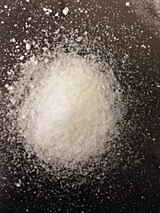
| |

| |
| Names | |
|---|---|
| Other names
Sodium rhenate(VII)
| |
| Identifiers | |
3D model (JSmol)
|
|
| ChEMBL | |
| ECHA InfoCard | 100.033.388 |
PubChem CID
|
|
| RTECS number |
|
| UNII | |
CompTox Dashboard (EPA)
|
|
| |
| |
| Properties | |
| NaReO4 | |
| Molar mass | 273.1866 g/mol |
| Appearance | white solid |
| Density | 5.39 g/cm3 |
| Melting point | 414 °C (777 °F; 687 K) |
| 103.3 g/100 mL (0 °C) 114.0 g/100 mL (25 °C)[1] 145.3 g/100 mL (30 °C) 173.0 g/100 mL (50 °C) | |
| Solubility | soluble in water (> 1130 g/L at 25 °C)[1] |
| Structure | |
| tetragonal | |
| Hazards | |
| Occupational safety and health (OHS/OSH): | |
Main hazards
|
Oxidizer, skin/eyes irritation |
Except where otherwise noted, data are given for materials in their standard state (at 25 °C [77 °F], 100 kPa).
| |
Sodium perrhenate (also known as sodium rhenate(VII)) is the inorganic compound with the formula NaReO4. It is a white salt that is soluble in water. It is a common precursor to other rhenium compounds. Its structure resembles that of sodium perchlorate and sodium permanganate.
Preparation[edit]
It can be prepared by treatment of rhenium heptoxide with base or by ion exchange from the potassium salt.[2]
Sodium perrhenate can be prepared from rhenium metal with hydrogen peroxide in the presence of base.[3]
Reactions[edit]
It reacts with sodium in ethanol to give nonahydridorhenate.[2]
Sodium perrhenate has been used as a precursor of rhenium nitrides (such as Re3N, Re2N, Re3N2, ReN2, ReN3, ReN4), which can be used as catalysts for ammonia synthesis and for hydro-denitrogenation.[4]
It can be used to prepare Re2(CO)10.[3]
References[edit]
- ^ a b Luis Cifuentes, J. M. Casas (February 2012). "Crystallization of Sodium Perrhenate from NaReO4–H2O–C2H5OH Solutions at 298 K". Hydrometalurgy. 113–114: 192–194. Bibcode:2012HydMe.113..192C. doi:10.1016/j.hydromet.2011.12.022.
- ^ a b A. P. Ginsberg; C. R. Sprinkle (1972). "Nonahydridorhenate Salts". Inorganic Syntheses. Vol. 13. pp. 219–225. doi:10.1002/9780470132449.ch45. ISBN 978-0-470-13244-9.
- ^ a b Crocker, Lisa S.; Gould, George L.; Heinekey, D. Michael (1988). "Improved Synthesis of Carbonylrhenium". Journal of Organometallic Chemistry. 342 (2): 243–244. doi:10.1016/s0022-328x(00)99461-0.
- ^ Hämäläinen, Jani; Mizohata, Kenichiro; Meinander, Kristoffer; Mattinen, Miika; Vehkamäki, Marko; Räisänen, Jyrki; Ritala, Mikko; Leskelä, Markku (2018-08-27). "Rhenium Metal and Rhenium Nitride Thin Films Grown by Atomic Layer Deposition". Angewandte Chemie International Edition. 57 (44): 14538–14542. doi:10.1002/anie.201806985. hdl:10138/325623. ISSN 1433-7851. PMID 30048031. S2CID 51721705.
Further reading[edit]
- Ahluwalia, J. C.; Cobble, J. W. (1 December 1964). "The Thermodynamic Properties of High Temperature Aqueous Solutions. II. Standard Partial Molal Heat Capacities of Sodium Perrhenate and Perrhenic Acid from 0 to 100o". Journal of the American Chemical Society. 86 (24): 5377–5381. doi:10.1021/ja01078a001.
- Dwek, Raymond A.; Luz, Z.; Shporer, M. (1 May 1970). "Nuclear magnetic resonance of aqueous solutions of sodium perrhenate". The Journal of Physical Chemistry. 74 (10): 2232–2233. doi:10.1021/j100909a038.
